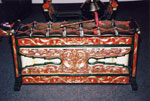Search for:
ARTISTIC
CONTRIBUTIONS
> Music > Southeast
Asian
The Sights and Sounds of
Gamelan
By Nur Intan Murtadza
Imagine entering a room and
seeing a pair of ornately carved teak stands joined by a horizontal
pole with golden sea serpents sitting sinuously on top. Beneath
it, bronze gongs hang heavily. These gongs are of various sizes
with raised knobs in their center. When struck, the room is filled
with a deep resonating sound that lingers on in our memories
long after. The largest of these hanging gongs is the gong ageng
(great/grand/big). It has a commanding presence and is the site
where offerings of flowers and incense are placed. As our eyes
move about the room, we see other bronze instruments such as
the family of tuned bronze metallophones (sarons, demung, peking),
the set of genders and slenthem (instruments with tuned keys
suspended over tubular resonators), various assortment of pot
gongs horizontally suspended over a wooden cavity, gambang (wooden
xylophone), rebab (spiked two-stringed fiddle), kendangs (two-headed
hand drums), plucked zither and bamboo duct flute. This is the
gamelan orchestra and the instruments described above come from
Indonesia and more specifically from Central Java.
 |
|
|
|
 |
|
|
|
 |
click to enlarge above
pictures
of gamelan instrument > |
Every gamelan is given a name
in a ritual ceremony called selamatan. Most names begin with
the honorific Javanese title Kyai (Venerable). For example, Gamelan
Kyai Mendung (Venerable Dark Cloud) was arranged by Ki Mantle
Hood (1918 - 2005), a renowned pioneer in the field of ethnomusicology,
to be brought to UCLA's Institute of Ethnomusicology. Gamelan
Kyai Mendung is one of the earliest gamelans to be founded in
a North American academic institution. York University's gamelan
has been conferred the female honorific title of Nyai Mirah Kencana
("Lady Brilliant Vermillion"). The instruments were
made in the royal Javanese cities of Surakarta and Yogyakarta.
Brilliantly coloured in red, blue and gold, the gamelan is as
beautiful to the eyes as it is to the ears. It has been generously
loaned to the Department of Music at York for teaching purposes
by the Consulate General of Indonesia, Toronto. York's gamelan
is tuned in laras slendro, one of the two traditional Javanese
tuning systems.
The process of gamelan tuning
is a fascinating ethnographic subject. A complete Central Javanese
gamelan consists of two tuning systems -- laras slendro and laras
pelog. Laras slendro is an anhemitonic five-note system and laras
pelog is a hemitonic seven-note system. Both Central Javanese
tuning systems do not correspond exactly to the Western twelve-tone
chromatic scale. While the instruments in a gamelan ensemble
are tuned to each other, a comparison between different gamelan
ensembles exhibits subtle degrees of variation. Perhaps the variability
in tuning is part of the Javanese aesthetic, which values the
individual soundscapes of particular ensembles. Nevertheless,
these variations do not go beyond certain acceptable ranges and
are confined within the socio-cultural constructs of taste and
rasa of the Javanese world.
How is gamelan played? One
sits on the ground with folded legs and shoes off, facing the
instruments. The practice of avoiding stepping over the instruments
is reinforced very early on as such an act would be considered
a breach of respect. Tabuhs (mallets) of various sizes are used
to strike the metallophones and gongs. Traditionally, the music
is learned aurally and the process involves much time listening
to and observing gamelan performances. While cipher notation
(using numbers to represent each pitch of the tuning system)
is prevalent today, the exercise of listening to each other is
vital as the character of gamelan music is based on communal
expression. No melody of a single instrument can be conceived
as separable from the whole sound of the ensemble.
Sample of Gamelan
music (WAV format, 6 MB download)4:41min
Media Player required to listen to audio clip
<<
top
 The project was made
possible with the support of the
The project was made
possible with the support of the
Department
of Canadian Heritage through the Canadian Culture Online Strategy
The Acrobat Reader
is available free from 